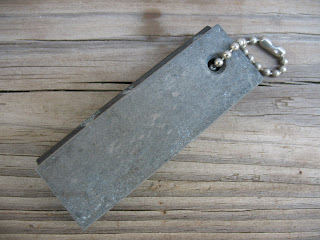
For hundreds of years prior to the invention of the safety match, flint and steel was the most commonly used method of starting a fire. The mechanics of flint and steel are pretty straight forward. You strike a flint rock with a piece of steel which produces sparks. The sparks fall into a combustible material where they take hold. The combustible material is transferred to a bundle of finely shredded tinder, and you blow on the combustible material to expand the spark and make it hotter. When the heat reaches a critical temperature the tinder bundle ignites.
Starting a fire with flint and steel is a skill that is still widely practiced by re-enactors of the French and Indian War, the Revolutionary War, and the American fur trade. When I was a kid ever Boy Scout in my troop was expected to start a fire with flint and steel and bring a pot of water to a boil in less than five minutes. Sadly, this is a skill that is no longer taught in scouting.
Now for the movie myths about starting a fire with flint and steel. In a scene from a popular movie about a young boy stranded alone in the Alaskan wilderness, the boy throws his new stainless steel axe and it hits a rock creating a shower of sparks. He gets a great idea. He picks up the rock, gathers a bundle of dry grass, and then bangs the rock and axe together making the sparks fall into the grass. The grass bursts into flame, and the boy has created fire. Nice movie scene, but it will never happen. Here’s why: Most people thing that when flint and steel produce sparks, it’s the flint that is sparking. Actually it is little fragments of the steel that are burning. A hard, sharp edged rock like flint will shave tiny pieces off of the steel, and the heat created by the friction of flint dragging across steel is sufficient to make the steel burn. Now, for the steel to burn it must have a very high carbon content, and stainless steel does not have a high carbon content. So, it won’t produce sparks. If you don’t believe me take any modern stainless steel knife and bang away. You won’t get any sparks.
The second reason why the above scenario wouldn’t work has to do with the heat of the sparks produced by striking flint to steel. The sparks produced by striking flint to steel are not hot enough to directly ignite a tinder bundle like dried grass or shredded cedar bark. To get the bundle to ignite you first have to catch the spark in an intermediary material that will catch the spark and ignite into a weak glowing burn. This material can then be transferred to the tinder bundle where a little blowing will cause the glowing material to burn hotter and will keep it in contact with the tinder for a longer period, allowing the heat to build up to the point of combustion.
The most commonly used intermediary material for starting a flint and steel fire is char-cloth. Char-cloth is cotton or linen cloth that has been burned inside of a nearly air-tight container so that it turns into a fragile, blackened char that is easily ignited.
Other things that I have personally used as char include charred fungus from a tree, and charred punk wood, which is a soft rotted wood. I have also read about a particular type of fungus that will catch a spark without charring if it is thoroughly dried. I believe it, but I’ve never seen it or tried it myself.
In fairness to the legend of striking sparks directly into natural tinder and starting a blaze, I have heard that it can be done. But I’ve never done it, and of the hundreds of people that I personally know that can start a fire with flint and steel, none of them can do it. So, I would say the chances of the average Joe making this work are not good.
There are a couple of man-made substances that you can ignite will a flint rock and steel. These are 0000 steel wool, and gun powder. I find it unlikely that you will come across any steel wool in the wilderness, but if you are hunting you will have some ammo. If you open a cartridge and pour out the powder, you will have something that you can light with flint rock and steel.
So, I don’t really consider fire by flint and steel to be a great option for survival fire starting. To start a flint and steel fire under survival circumstances you would need to have or find something made of high carbon steel, you would have to be in an area where flint rocks can be found (not as common as you would think), and you would have to be able to identify and dry some of the mystery fungus that doesn’t need to be charred, or stumble across an old campfire that contains some charred punk wood. Sounds pretty iffy to me. Of course you could carry a flint and steel kit with you everywhere you go, but wouldn’t a disposable lighter be easier?
With all that said, let’s learn how to start a fire with flint and steel anyway. You never know, and besides it’s kind of fun. In the next post we’ll start getting our equipment together by finding a flint rock and selecting a fire steel.





















































